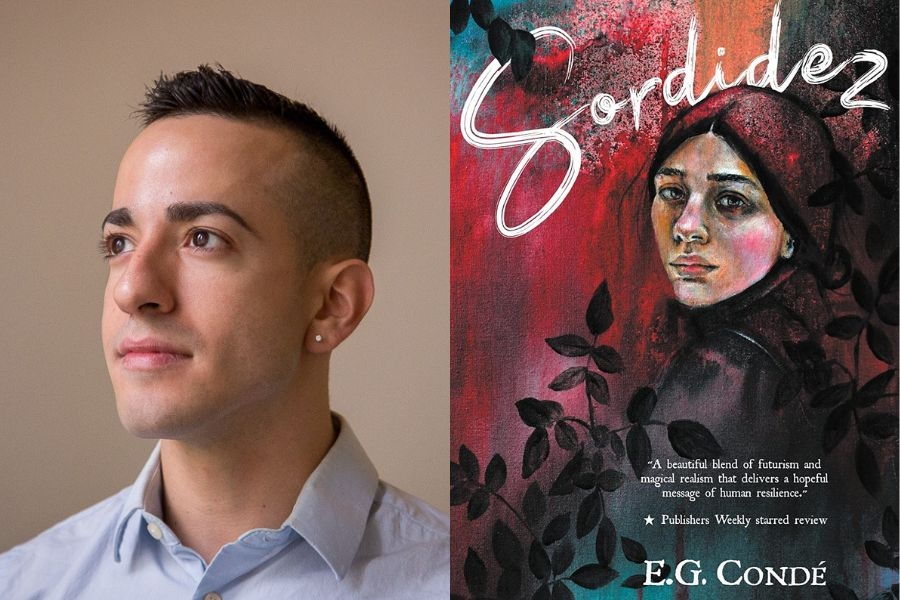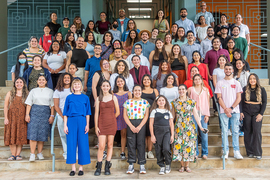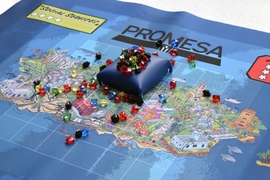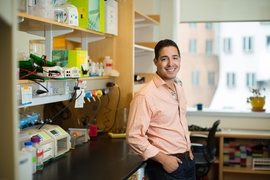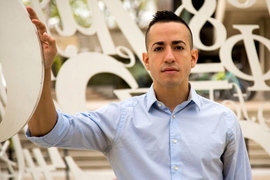Steven Gonzalez is a PhD candidate in the MIT Doctoral Program in History, Anthropology, Science, Technology, and Society (HASTS), where he researches the environmental impacts of cloud computing and data centers in the United States, Iceland, and Puerto Rico. He is also an author. Writing under the name E.G. Condé, he recently published his first book, “Sordidez.” It’s described as an “Indigenous futurist science fiction novella set in Puerto Rico and the Yucatán.” Set in the near future, it follows the survivors of civil war and climate disaster led by protagonist Vero Diaz, as they reclaim their Indigenous heritage and heal their lands.
In this Q&A, Gonzalez describes the book's themes, its inspirations, and its connection to research, people, and classes at MIT.
Q: Where did the inspiration for this story come from?
A: I actually began my time at MIT in September of 2017 when Hurricane María struck. It was a really difficult time for me at the Institute, starting a PhD program. And it's MIT, so there's a lot of pressure. I was still kind of navigating the new institutional space and trying to understand my place in it. But I had a lot of people at the Institute who were extremely supportive during that time. I had family members in Puerto Rico who were stranded as a result of the hurricane, who I didn't hear from for a very long time — who I feared dead. It was a very, very chaotic, confusing, and emotionally turbulent time for me, and also incredibly difficult to be trying to be present in a PhD program for the first semester. Karen Gardner, our administrator, was really incredibly supportive in that. Also the folks at the MIT Association of Puerto Ricans, who hosted fundraisers and linked students with counseling resources. But that trauma of the hurricane and the images that I saw of the aftermath of the hurricane, specifically in the town where my grandmother's house was where I spent time living as a child during the summers, and to me, it was the greenest place that I have ever known. It looked like somebody had torched the entire landscape. It was traumatizing to see that image. But that kind of seeded the idea of, is there a way to burn without fire? There's climate change, but there's also climate terror. And so that was sort of one of the premises of the book explores, geoengineering, but also the flip side of geoengineering and terraforming is, of course, climate terror. And in a way, we could frame what's been happening with the fossil fuel industry as a form of climate terror, as well. So for me, this all began right when I started at MIT, these dual tracks of thought.
Q: What do you see as the core themes of your novella?
A: One major theme is rebuilding. As I said, this story was very influenced by the trauma of Hurricane María and the incredibly inspiring accounts from family members, from people in Puerto Rico that I know, of regular people stepping up when the government — both federal and local — essentially abandoned them. There were so many failures of governance. But people stepped up and did what they could to help each other, to help neighbors. Neighbors cleared trees from roads. They banded together to do this. They pooled resources, to run generators so that everyone in the same street could have food that day. They would share medical supplies like insulin and things that were scarce. This was incredibly inspiring for me. And a huge theme of the book is rebuilding in the aftermath of a fictive hurricane, which I call Teddy, named after President Theodore Roosevelt, where Puerto Rico's journey began as a U.S. commonwealth or a colony.
Healing is also a huge theme. Healing in the sense of this story was also somewhat critical of Puerto Rican culture. And it's refracted through my own experience as a queer person navigating the space of Puerto Rico as a very kind of religious and traditional place and a very complex place at that. The main character, Vero, is a trans man. This is a person who's transitioned and has felt a lot of alienation and as a result of his gender transition, a lot of people don't accept him and don't accept his identity or who he is even though he's incredibly helpful in this rebuilding effort to the point where he's, in some ways, a leader, if not the leader. And it becomes, in a way, about healing from the trauma of rejection too. And of course, Vero, but other characters who have gone through various traumas that I think are very much shared across Latin America, the Latin American experiences of assimilation, for instance. Latin America is a very complex place. We have Spanish as our language, that is our kind of lingua franca. But there are many Indigenous languages that people speak that have been not valued or people who speak them or use them are actively punished. And there's this deep trauma of losing language. And in the case of Puerto Rico, the Indigenous language of the Taínos has been destroyed by colonialism. The story is about rebuilding that language and healing and “becoming.” In some ways, it's about re-indigenization. And then the last part, as I said, healing, reconstruction, but also transformation and metamorphosis. And becoming Taíno. Again, what does that mean? What does it mean to be an Indigenous Caribbean in the future? And so that's one of the central themes of the story.
Q: How does the novella intersect with the work you’re doing as a PhD candidate in HASTS?
A: My research on cloud computing is very much about climate change. It's pitched within the context of climate change and understanding how our digital ecosystem contributes to not only global warming, but things like desertification. As a social scientist, that's what I study. My studies of infrastructure are also directly referenced in the book in a lot of ways. For instance, the now collapsed Arecibo Ionosphere Observatory, where some of my pandemic fieldwork occurred, is a setting in the book. And also, I am an anthropologist. I am Puerto Rican. I draw both from my personal experience and my anthropological lens to make a story that I think is very multicultural and multilingual. It's set in Puerto Rico, but the other half is set in the Yucatán Peninsula in what we'll call the former Maya world. And there's a lot of intersections between the two settings. And that goes back to the deeper Indigenous history. Some people are calling this Indigenous futurism because it references the Taínos, who are the Indigenous people of Puerto Rico, but also the Mayas, and many different Maya groups that are throughout the Yucatán Peninsula, but also present-day Guatemala and Honduras. And the story is about exchange between these two worlds. As someone trained as an anthropologist, it's a really difficult task to kind of pull that off. And I think that my training has really, really helped me achieve that.
Q: Are there any examples of ways being among the MIT community while writing this book influenced and, in some ways, made this project possible?
A: I relied on many of my colleagues for support. There's some sign language in the book. In Puerto Rico, there's a big tradition of sign language. There's a version of American sign language called LSPR that's only found in Puerto Rico. And that's something I've been aware of ever since I was a kid. But I'm not fluent in sign language or deaf communities and their culture. I got a lot of help from Timothy Loh, who's in the HASTS program, who was extremely helpful to steer me towards sensitivity readers in the deaf community in his networks. My advisor, Stefan Helmreich, is very much a science fiction person in a lot of ways. His research is on the ocean waves, the history and anthropology of biology. He's done ethnography in deep-sea submersibles. He's always kind of thinking in a science fictional lens. And he allowed me, for one of my qualifying exam lists, to mesh science fiction with social theory. And that was also a way that I felt very supported by the Institute. In my coursework, I also took a few science fiction courses in other departments. I worked with Shariann Lewitt, who actually read the first version of the story. I workshopped it in her 21W.759 (Writing Science Fiction) class, and got some really amazing feedback that led to what is now a publication and a dream fulfilled in so many ways. She took me under her wing and really believed in this book.
